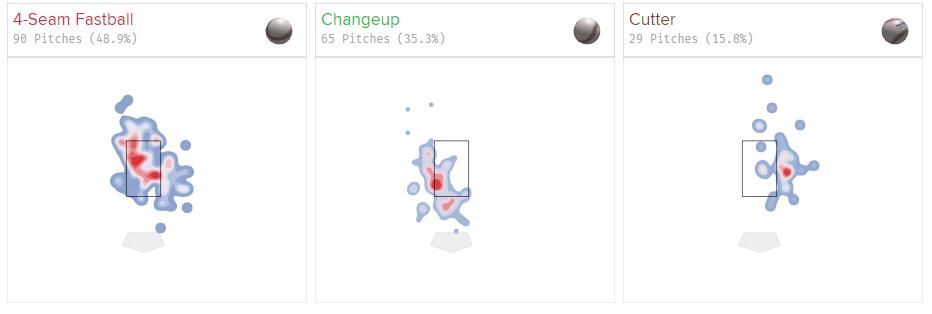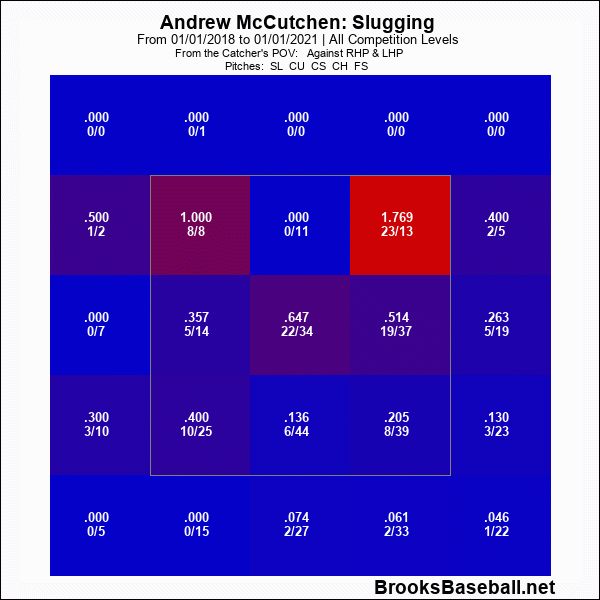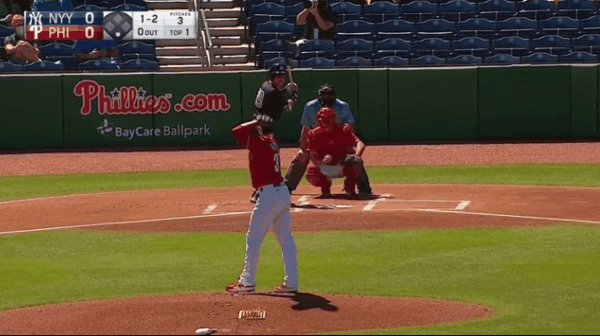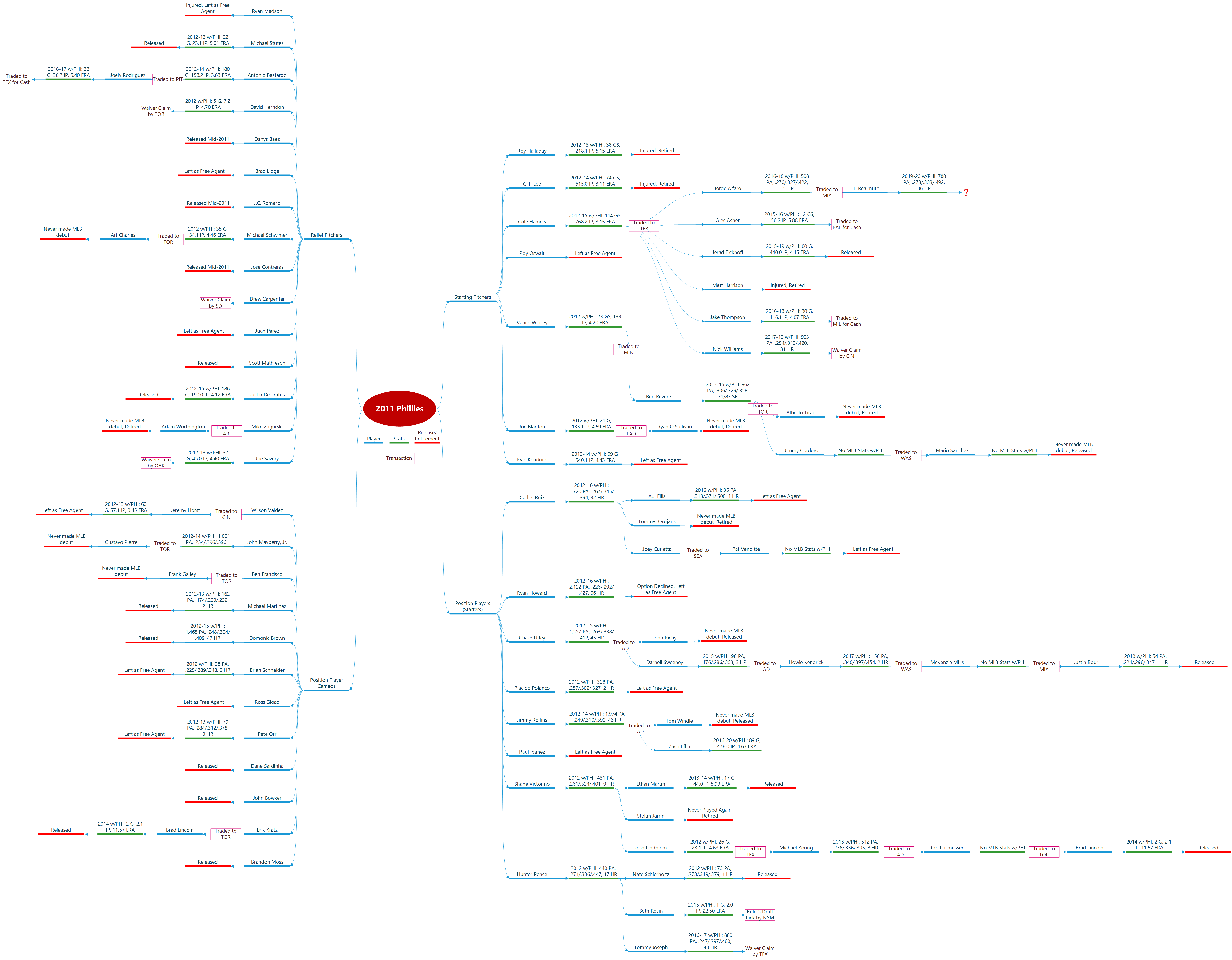For more than a decade, Matt Swartz and MLB Trade Rumors have partnered up to publish a reliable, accurate model of expected arbitration salaries. This offseason’s slate of projections is out, and we have some thinking to do .
The Phillies have nine arb-eligibles: One starting pitcher, two relievers, three outfielders, a catcher, a utility infielder, and a first baseman, all important or unimportant in various ways. Roster Resource currently has the Phils at ~$121 million before buyouts, benefits, and these projected arbitration numbers, and ~$143 million after factoring in all but the arbs. Keep that $143 million figure in mind as we go through this; we’ll come back to it.
So, here’s what we have…
- Odubel Herrera – $11.6MM
Worth It?
No. Leaving the aside the bad-person aspect of this guy’s case and focusing solely on baseball things for this moment, it’s hard to justify any salary for him that has eight figures. After a year-and-a-half away between his suspension and being left off the roster for the shortened 2020 season, Herrera came back and was…exactly the same as he was in 2018: Very meh.
2018: .255/.310/.420, 94 OPS+
2021: .260/.310/.416, 95 OPS+
The only really noticeable change is a sharp drop in strikeouts, after a change in approach turned him into more of a slap hitter who found some extra ground ball singles against shifts. And while there’s value in making contact in today’s game, the quality of contact obviously didn’t follow; it was a different path to the same results, with home runs exchanged for doubles.
There’s also the fact that he repeatedly led off for this team, despite posting a .287 OBP when batting first. Among Phillies hitters who started at least 60 games at leadoff (Herrera had 63), that .287 OBP is tied with Larry Bowa’s 1971 for sixth-worst out of 117 qualifiers. You have that to thank, in part, for Bryce Harper’s weirdly low RBI total.
Will He Be Around?
You’d hope that a club with capital-r Resources would find a better option in center field than a below-average bat whose questionable decision-making on and off the field (putting it gently) does not seem to have changed after a roughly two-year break. But I’m not convinced.
The word is that Girardi stumped for Herrera in Spring Training last season, and the incredibly long leash he was afforded during his slumps kind of backs up the whispers of managerial favor. Why, exactly, he curried such favor I don’t think any one of us on the outside really fully knows. Add onto that the very, very thin upcoming center field free agent market — it’s basically Starling Marte and a slew of role players or platoon partners, depending on how you fancy Kris Bryant’s ability out there — and it’s not exactly a buyer’s market out there. What’s more, basically every other internal option to start the year burned out: Roman Quinn’s Achilles gave out in late May (more on him in a minute); Adam Haseley temporarily left the team in April for personal reasons, battled injury and the COVID-19 list, finally returned and posted a .226/.284/.283 line in his final 27 games with Lehigh Valley; Mickey Moniak never really got a look as a regular CF and didn’t hit well in the limited action he did get. Matt Vierling, a surprise latecomer, wasn’t even on the call-up radar until August, and his future as a regular CF is very much uncertain.
I, personally, fancy Bryant’s glove in CF pretty favorably. He looks pretty alright out there! But Marte and Bryant are marquee names who’ll likely have plenty of options. The internal backups inspire no confidence right now. Trades will be hard to come by, and the team’s prospect capital may be best spent upgrading elsewhere. Put it all together, and it feels slightly more likely than not that Herrera will be back.
There’s a bit of math that goes into retaining him, explained below:
Money is a significant factor working against Herrera, but the possibility of declining his 2022 option (very likely) and tendering him a contract as an arbitration-eligible player — remember, his suspension stopped his service time clock, so the option that was presumed to cover his first year of free agency when the contract was signed instead covers an arbitration-eligible year because he doesn’t have enough service to become a free agent — can’t be written off.
The maximum a player’s salary can decrease through arbitration is 20 percent; whether that applies to AAV or actual dollars (the latter being my belief) I’m not 100 percent sure, but against actual dollars that means his lowest possible salary through arbitration would be a hair over $8.25 million. There’s a chance the team could non-tender him and re-sign him for less than that as an accounting trick; he’d probably have some nibbles of interest elsewhere, but it’s hard to imagine lots of teams knocking down the door (and if they do, well, fine, bye).
As much as I’d like the team to move on, there are just too many paths toward his return right now that I can’t be completely sure which way they’re going to go yet.
- Travis Jankowski – $900K
Worth It?
Before this season? No. He was firmly in non-roster invitee land forever and ever, amen. But Jankowski was okay at the plate — .252/.364/.351 in 157 PA — and played a decent center field, even though his numbers seriously lagged in the second half. As far as NRIs go, he was a modest success (especially in light of, like, Matt Joyce), but there isn’t a lot of reason to believe he can do what he did in the first half of 2021 again.
Will He Be Around?
I don’t think another team would want Jankowski on a guaranteed deal based on his 2021. Maybe the comforts of playing for his hometown club give him a bit of a boost that other cities couldn’t quite match, who’s to say? In any case, tendering Jankowski wouldn’t surprise me, with Brad Miller’s likely departure and the lack of confidence in Moniak and Haseley as left-handed OFers at the moment leaves something of a depth void. If one of those two (or some other dark horse) surges ahead after a couple strong months at Lehigh, a prorated portion of $900k is a figure that won’t stand in their way.
- Zach Eflin – $6.0MM
Worth It?
Not an easy question to answer. The timing of Eflin’s knee trouble resurfacing couldn’t be worse; before the ’21 season, he was a potential multi-year extension candidate. Now, after a decent-but-not-breakout year and another surgery, Eflin’s future is much cloudier. When healthy, Eflin has definitely been worth No. 3 starting pitcher money, and $6 million isn’t much more than the Phillies were spending on No. 4s and 5s. It all comes down to health at this point.
Will He Be Around?
And that health aspect is what will make this an ongoing storyline into next year. It’s possible his recovery from surgery is already going a bit poorly and Eflin may be non-tendered when the season ends and the 60-day IL goes away, but that’s the disaster scenario. Eflin’s knee would need to be in very bad shape to boot him off the 40 that soon. He’s worth the shot, even for a partial season.
- Andrew Knapp – $1.2MM
Worth It?
Not really. I’m not sure how we’re still in this spot. There was enough reason to be like, “you know what, I’ve seen enough” after 2019, but his (apparently fluky) 2020 sprint season was actually good, all 89 plate appearances of it. So that earned him just a bit over $1 million and the right to prove it wasn’t a fluke in 2021; instead, he had one of the worst offensive years of any non-pitcher this century. There’s a benefit to positive clubhouse presence (which Knapp seems to be), and that’s not nothing for a clubhouse that sure seemed like it was a tense one for most of this year. But how good do you have to be off the field to justify how bad ’21 was on it?
Will He Be Around?
It’s just so hard to picture a Phillies team without Andrew Knapp as backup catcher anymore. He was called up in 2017 and has never been optioned back down! Not once! Not matter how bad things got, the Phillies somehow never had a better option at backup catcher. It’s as much an indictment of the organization’s rosters over the past five years as it is of Knapp, and ’22 might not be different! Rafael Marchan looks promising and could probably hold his own as a backup next season, but he’s still very young (23 in February) and the team probably wants him to get everyday reps in Triple-A. With such a small raise pending and the catching market looking dicey (Yan Gomes? Sandy Leon? Kurt Suzuki?), we may yet get Year 6 of the Knapp Experience. A full season in the Majors will get him enough service time to finally be eligible for free agency next winter.
- Jose Alvarado – $1.9MM
Worth It?
Sure. The walks are insane and heavily counterbalance the raw stuff, but that raw stuff is also kind of insane in its own right and worth the price tag to continue tinkering with. But an opponents’ on-base of .382 is straight-up bad and needs to be better.
Will He Be Around?
Yup. But the case won’t be as open-and-shut next year if he can’t throw more strikes.
- Rhys Hoskins – $7.6MM
Worth It?
Absolutely. Hoskins continues to frustrate in his intense battles with streakiness, but the body of work, on balance, keeps showing him coming out ahead. If nothing else, his absence in the stretch run of this season was felt pretty strongly as Brad Miller took over as the primary 1B and hit .209/.303/.454.
Will He Be Around?
Yes. There’s still the question of Hoskins’s long-term future after 2023, his current projected final year of arbitration. It doesn’t feel like there’s a multi-year deal in the tea leaves this offseason, so that’s probably a discussion for another year, but as far as 2022 is concerned he’s a sure thing to be tendered.
- Ronald Torreyes – $1.6MM
Worth It?
Don’t think so. He’s been waived and released and traded for cash and non-tendered a whole bunch already, and his .242/.286/.346 in a career-high 344 PA last season doesn’t really move the needle away from that. He looks like a capable defender around the infield, but that might not justify a guaranteed deal by itself.
Will He Be Around?
Maybe. Torreyes is something of a minor cult hero right now after stringing up a few clutch hits in ’21, but he’s not a strong bat and the Phillies (finally, thankfully) have a couple of internal utility candidates in Nick Maton and Luke Williams who should get first looks. There’s also Bryson Stott’s role to consider, since he should be knocking on the door for a call-up this coming summer. Guaranteeing a contract and spot to Torreyes just constricts the pipeline (what there is of it), and would likely cost another fringe organizational player (think Luis Garcia, for one example) a spot on the 40-man and protection from this winter’s Rule 5 Draft.
- Seranthony Dominguez – $800K
Worth It?
Yes. It was great to see Seranthony complete his comeback from Tommy John surgery with an appearance in game 162, and he should factor into the team’s bullpen plans for ’22. Exactly how much he’ll be able to pitch isn’t known, but even if it’s just a couple months’ worth of average innings, that’s worth a sub-million figure in today’s game. You take a flier at that figure on a guy with Seranthony’s potential 10 times out of 10.
Will He Be Around?
Absolutely. Again, the only question is how much he’ll be around at the Major League level. He’s still fresh off recovery and can’t be counted on for 70 appearances, but I’m sure we’ll all take what we can get. He’ll have a minor league option, so the team will be able to manage his workload between Philly and Lehigh a bit more effectively that way.
- Roman Quinn – $700K
Worth It?
I want to say yes. I really, really do. I like Quinn and I think his skillset — a fast, switch-hitting outfielder who can handle all three OF spots — is the platonic ideal of a guy you want on your bench. But the problem in 2021 was the same problem in 2020, and 2019, and 2018, and 2017 and…
It’s a completely open question as to whether he’d be able to take the field, so it’s less a question of being worth the money ($700 thousand is basically nothing in baseball terms, ~$150 thousand over league minimum) than it is being worth the roster spot. The Phillies have a number of players worth consideration for Rule 5 protection, and Quinn (who turns 29 next May) has lost considerable ground with his injuries.
Will He Be Around?
Look, like we just reviewed, Quinn can’t stay healthy. Freak injury or low durability, whatever the case, he simply can’t seem to avoid the IL. This latest injury, a ruptured Achilles tendon, is particularly severe, and could be what finally costs Quinn a spot on the 40-man after years of chances.
It’s no sure thing either way — Quinn was on the chopping block as recently as this past Spring — but diminishing performance and availability are never a good recipe for job security.




